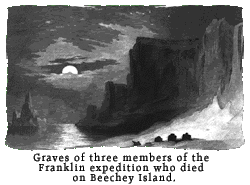|
Northern Vignettes
Arctic Harpoons
Beechey Island
Crystal II
Deline/Fort Franklin
Fort Hope
Fox Moth
Kellet's Storehouse
Naujan
Old Fort Providence
Old Fort Reliance
Stone Church
Thule Village
Yellowknife
Fort Journal

The Franklin MysteryIn July 1845, Sir John Franklin and his crew of 129 men entered the waters of Lancaster Sound in search of the Northwest Passage. Although they were never again seen by Europeans, Franklin's party was the largest and best equipped sent by the British Admiralty to the Arctic Archipelago in quest of a navigable northern route to the Far East. The Admiralty's search for the missing expedition began two years later and continued until 1880. After exploring Wellington Channel to 77 degrees North Latitude, and circumnavigating Cornwallis Island, the expeditioners passed the first winter at Beechey Island. The following summer, they probably sailed south through Peel Sound and Franklin Strait. The ships, H.M.S. Erebus and H.M.S. Terror, were beset by ice to the north of King William Island, off Cape Felix, in September 1846. A note left in a cairn at Victory Point, King William Island conveyed the information that Sir John Franklin had died on 11 June 1847 and that the 105 remaining crew members, led by Francis Crozier, the Captain of the Terror, would begin a trek south along the western coast of King William Island toward the Back River, after leaving the ice-bound ships in April 1848. All perished. Neither records of the expedition nor the ships have ever been found. Inuit of the Pelly Bay area shared their knowledge of the fate of the Franklin men with Hudson's Bay Company Chief Factor, Dr. John Rae in 1853. Rae learned that a large party of 'white men', qabluna, had perished from want of food at a place later understood to be western King William Island. He purchased relics which had belonged to the Europeans. For recovering and returning this information to Britain, Rae was awarded a prize of £10,000 by the British Admiralty. His news that Franklin's men had resorted to cannibalism so affronted Britons' sensitivities that controversy raged. Use of Inuit evidence shows that the expedition's fate may have been more complicated than previously understood. The ships may have been remanned after their abandonment for seasonal hunting in 1848; a very few of the expeditioners may have survived until 1851 and travelled as far east as Melville Peninsula. |